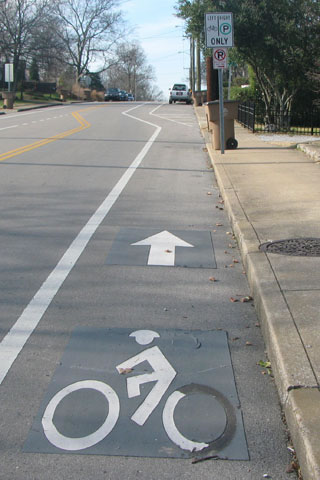| 491 | Traffic Calming | 2011-10-06 |

We live in a neighborhood close to Vanderbilt University in Nashville, TN. Each morning and evening, workers speed along trying to reach their jobs at the University, the Medical Center, or the businesses that support the University. Almost everyone seems to be in a hurry to get to wherever they are heading. When the main arteries become clogged then the traffic tries to bypass the congestion by traveling through the neighborhood streets. The speedy drivers have led to traffic calming measures on some avenues.
One calming technique that has been used on a neighborhood street for a few years is lane changing. The concept works by using abrupt lane changes that naturally slow the traffic. The once, straight as a drag strip, road has been re-lined to provide traffic slowing curves.
I frequent the street, as it is a leg of one of my daily running routes. So, I have observed the traffic over the years. When the lane changes were first added to the street, drivers would slow their speed and meticulously steer, keeping their vehicles between the lines. However, as time progressed, the lines became more of a suggestion as to where traffic should travel. Each abrupt turn, became an elongated, easy, veer. The vehicles just drive outside of the lane until it is easy to straighten their path. After all you can't take a sharp turn safely at that speed. Instead of the road being as straight as a drag racing strip, the road has now become a Le Mans road course.
I used to run in the bike lanes of the avenue; but after a couple of speeding cars that swerved through the course like Speed Racer, I decided that it was probably safer to go to the sidewalk, at least there was a curb to protect me.
A few traffic calming tips ...
The lane changing traffic calming technique is a form of chicanes. Relying on painted lines to slow traffic does not seem to be effective. A deterrent must be added to keep the vehicles in their lanes.
Many chicanes use curbs to follow the "S". Behind the protected curb are mini landscaped areas. The curbs help slow traffic. The drivers slow to avoid damaging their wheels.
On the avenue with the lane changing, the speed limit has never been lowered and four way stops have not been installed at all the crossing streets.
Commuters who have to drive long distances, drive faster. When buying a house, closeness to work should be a priority.
On any commute, leave yourself enough time for travel and slow down.
Use public transportation.
Walk to work or ride a bicycle.
Happy lane changing trails